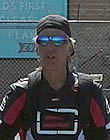|
|
This topic comprises 2 pages: 1 2
|
|
Author
|
Topic: DTS Dropout on older Acetate
|
|
|
|
|
|
|
|
|
|
|
|
|
|
|
John Hawkinson
Film God

Posts: 2273
From: Cambridge, MA, USA
Registered: Feb 2002
|
 posted 05-05-2010 06:54 PM
posted 05-05-2010 06:54 PM




Well, the timecode is a 5V signal, and that's close enough to line-level that you can just directly patch it into an audio amplifier (start with the volume turned down low if you're worried). You have to break out the signal and ground pin from the timecode cable, of course. We have a patch panel in our rack so this is easy to do "live" without disconnecting it from the DTS processor.
I should add, we have DFS's print #958 of Men in Black this week (one of the better prints, I'm told), and R2 seems to have this shrunken problem, so we did this adjustment earlier this week. ![[Smile]](smile.gif) [I'm 75% sure this is a polyester print, but even old polyester prints can show DTS lateral shifts over time. It does keep shrinking when you're talking about decades...] [I'm 75% sure this is a polyester print, but even old polyester prints can show DTS lateral shifts over time. It does keep shrinking when you're talking about decades...]
--jhawk
| IP: Logged
|
|
|
|
|
|
|
|
|
|
John Hawkinson
Film God

Posts: 2273
From: Cambridge, MA, USA
Registered: Feb 2002
|
 posted 05-05-2010 11:21 PM
posted 05-05-2010 11:21 PM




Yeah, as Tony said, you should be fine with a serial breakout device. I don't think LEDs are going to hurt anything, the worst that might happen is you burn out the LED with the timecode LED driver current...
They make "standard serial Y cables"? Who knew?! I didn't. But certainly the DTS cable is not a pin-for-pin straight through Y. And for that reason, if you make a DTS-to-audio adapter cable (or DTS-to-BNC Y splitter like they show in the manual), in a changeover setup, you have to use it on the TCR end of the Y cable, otherwise you'll only get Projector #1, since the Y cable swaps the Proj#1 and Proj#2 timecode inputs at the reader end, so both readers can be identical.
Quite possibly this is all too much effort -- you can just twist the adjustment until you get a solid green light on the timecode feedback green LED on the timecode reader...
--jhawk
| IP: Logged
|
|
|
|
|
|
|
|
All times are Central (GMT -6:00)
|
This topic comprises 2 pages: 1 2
|
Powered by Infopop Corporation
UBB.classicTM
6.3.1.2
The Film-Tech Forums are designed for various members related to the cinema industry to express their opinions, viewpoints and testimonials on various products, services and events based upon speculation, personal knowledge and factual information through use, therefore all views represented here allow no liability upon the publishers of this web site and the owners of said views assume no liability for any ill will resulting from these postings. The posts made here are for educational as well as entertainment purposes and as such anyone viewing this portion of the website must accept these views as statements of the author of that opinion
and agrees to release the authors from any and all liability.
|

 Home
Home
 Products
Products
 Store
Store
 Forum
Forum
 Warehouse
Warehouse
 Contact Us
Contact Us




 Printer-friendly view of this topic
Printer-friendly view of this topic







![[Smile]](smile.gif) [I'm 75% sure this is a polyester print, but even old polyester prints can show DTS lateral shifts over time. It does keep shrinking when you're talking about decades...]
[I'm 75% sure this is a polyester print, but even old polyester prints can show DTS lateral shifts over time. It does keep shrinking when you're talking about decades...]




